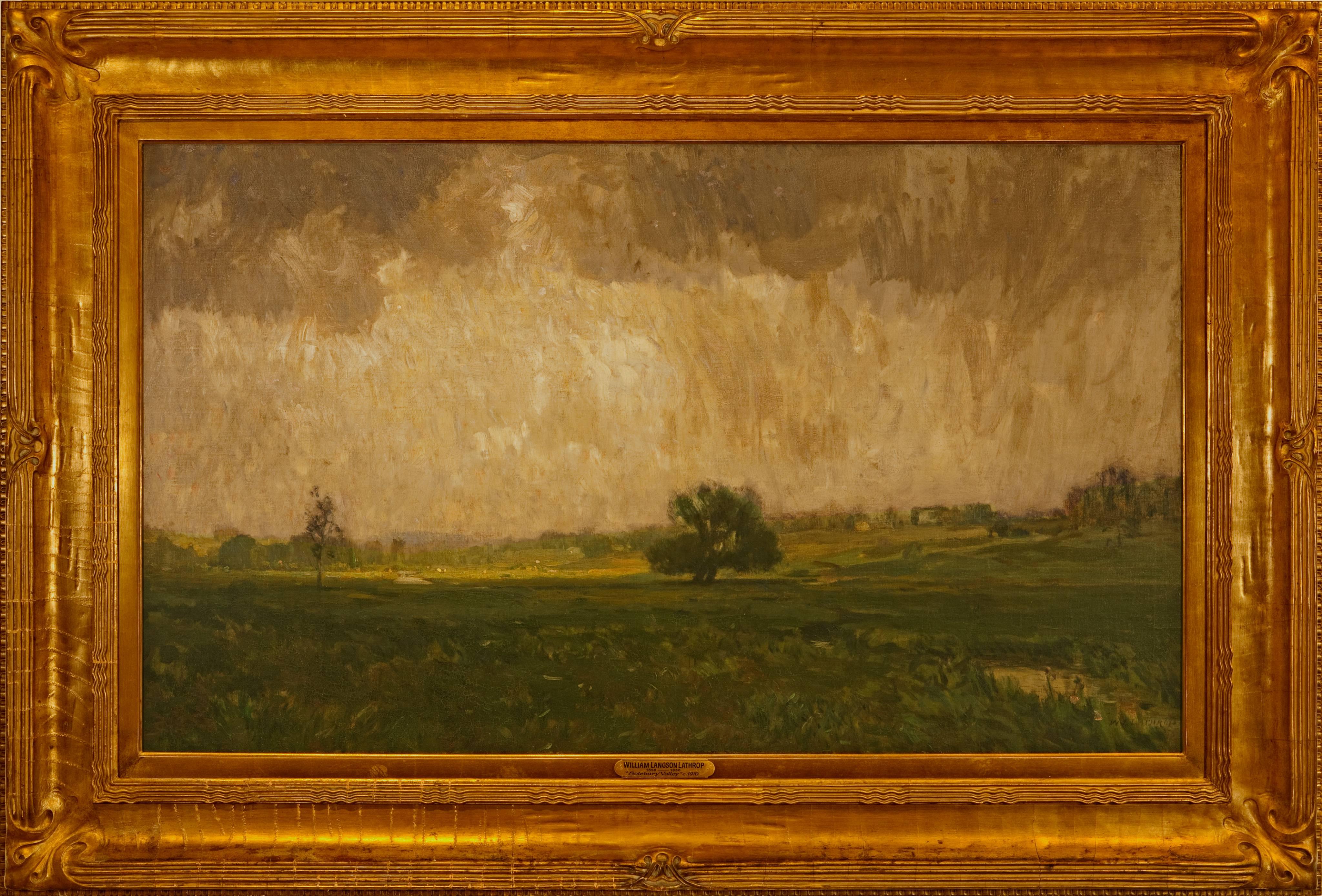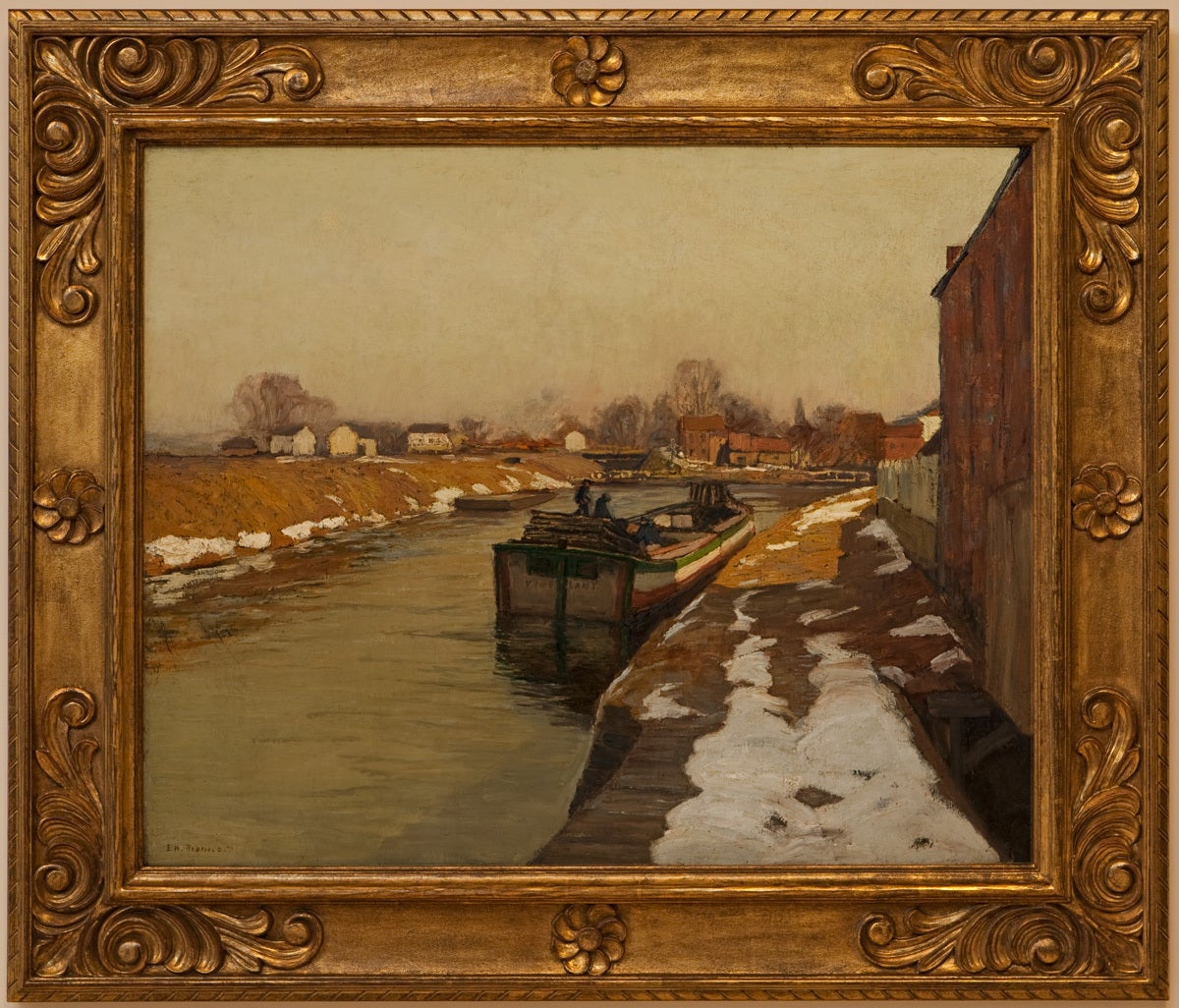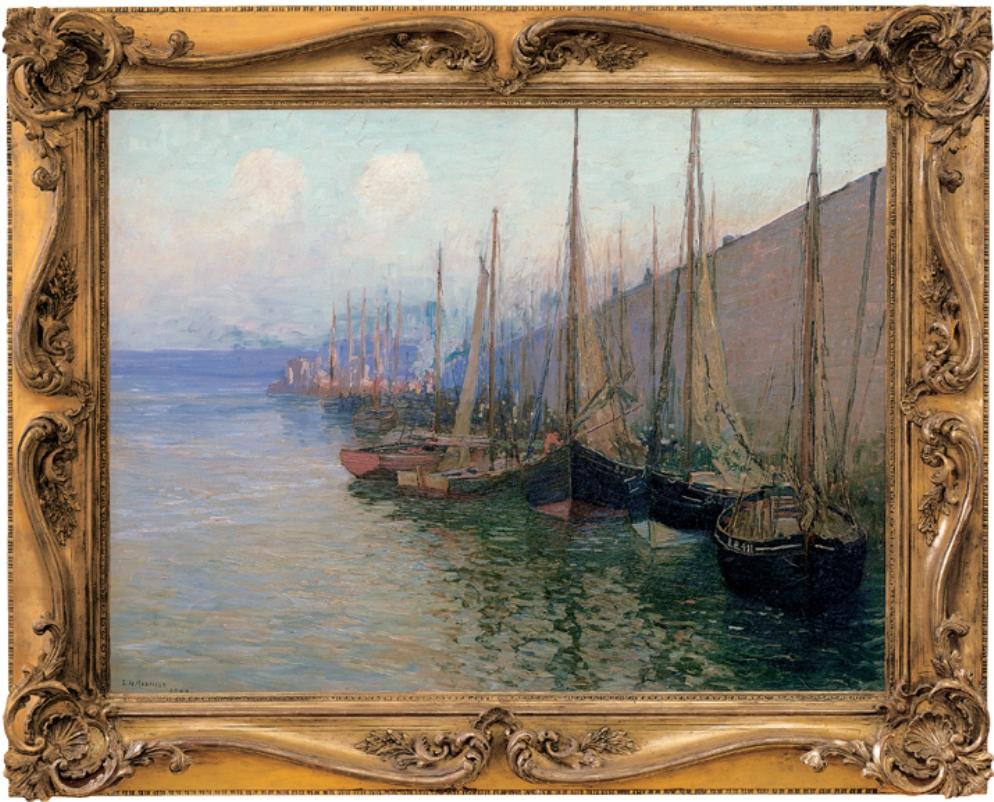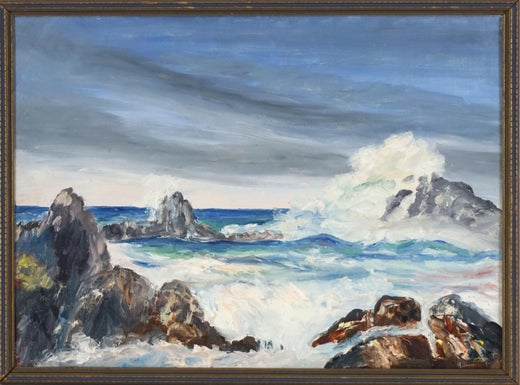Hartzell Harrison Ray"Rolling Seas", San Mateo Coast Landscape by Hartzell Harrison Ray 1978
1978
About the Item
- Creator:Hartzell Harrison Ray (1896 - 1991, American)
- Creation Year:1978
- Dimensions:Height: 24 in (60.96 cm)Width: 36 in (91.44 cm)Depth: 1 in (2.54 cm)
- Medium:
- Movement & Style:
- Period:
- Condition:
- Gallery Location:Soquel, CA
- Reference Number:
Hartzell Harrison Ray
Hartzell Harrison Ray was born in Kansas in 1896. Ray was a longtime resident of San Mateo, CA. He attended the University of Kansas in the 1900s. Reared in Kansas, he served in World War I and spent two postwar years teaching high school. He received his A.B. and M.D. from George Washington University and interned there and in Rochester. It was in the latter city that he met his charming wife, Anne, who was the supervising surgical nurse. The Rays were married in 1925 and had two children. Ray was one of the founders of the San Mateo Medical Clinic. He taught clinical pediatrics at the University of California Medical Center for 30 years. Retirement had given Ray more time for traveling. And because he was a representational marine artist, he was able to indulge in his passion for painting seascapes, particularly on the San Mateo County coast.
Hartzell Ray had never stopped learning. Monday afternoons were devoted to painting at the San Mateo County Fair building with Earl Pierce of the Peninsula Art Association. He was also sitting in as an observer in the docent course in Chinese art at the de Young Museum. Ray shied away from personal publicity, but his enthusiasm for art overcame his reticence to talk about himself.
"I started painting during World War II," Ray recalled. "I was making a house call in South San Mateo and, as I was returning along El Camino, I saw a fellow in the window of a big empty building painting. 'I’d like to do that,' I said to myself as I knocked on the door. It was answered by Mr. Polla, an itinerant artist, and I told him I wanted to learn to paint. 'Go uptown and buy the cheapest paints and brushes you can find,' he said, 'and come back tomorrow night.' And that's the way it started," Dr. Ray concluded with a smile. He was a member of the Foster City Art League and helped organize the Peninsula Art Association, where he served as its president and a member of the board of directors.
- ShippingRetrieving quote...Ships From: Soquel, CA
- Return PolicyA return for this item may be initiated within 14 days of delivery.
- Monterey Coastal Mountains LandscapeBy Jack LynnLocated in Soquel, CAGorgeous plein air landscape painting of green fields with California mountains and the coast in the background by Monterey area artist Jack Lynn (American, 20th Century). Unframed. ...Category
1990s American Impressionist Landscape Paintings
MaterialsOil, Canvas
- Man and His Guitar FigurativeBy Michael William EgglestonLocated in Soquel, CAContemporary oil painting of a man playing his guitar on the front porch by San Francisco artist Michael William Eggleston (American, 20th century). From a collection of his works. M...Category
Early 2000s American Impressionist Figurative Paintings
MaterialsCanvas, Oil
- Mid Century Monument Valley Desert Landscape -- Navajo Hogan and Rug LoomBy Ralph HolmesLocated in Soquel, CASubstantial and period mid-century landscape of Monument Valley, Arizona of Navajo Hogan and rug weaving loom by Ralph Holmes (American, 1876-1963). c.194...Category
1940s American Impressionist Landscape Paintings
MaterialsCanvas, Oil
- Mid Century Desert Mountain LandscapeBy Faith DoughertyLocated in Soquel, CASweeping mid century landscape of stark desert mountains by Faith Dougherty (American, 20th Century). Presented in a rustic wood frame. Signed "Faith ...Category
1960s American Impressionist Landscape Paintings
MaterialsOil, Canvas
- Morning Sunrise, Mid Century Laguna Hills Figurative LandscapeLocated in Soquel, CABeautiful mid century plein air figural landscape of Laguna Niguel, California by an unknown artist (American, 20th Century). The morning sun gli...Category
1950s American Impressionist Landscape Paintings
MaterialsCardboard, Oil, Canvas
- Mid Century California Lake House LandscapeLocated in Soquel, CALovely landscape oil painting of quaint lake houses along the water front with vibrant gold and green hills in the background by J. A. Dockeray (American, 2...Category
Mid-20th Century American Impressionist Landscape Paintings
MaterialsCanvas, Oil
- "Alley Fiends"By John R. GrabachLocated in Lambertville, NJJim’s of Lambertville is proud to offer this artwork by: John R. Grabach (1886 - 1981) John Grabach was a highly regarded New Jersey artist, teacher, and author of the classic text...Category
1930s American Impressionist Landscape Paintings
MaterialsCanvas, Oil
- "Forest Strongholds"By John F. CarlsonLocated in Lambertville, NJSigned lower right. Complemented by a hand carved and gilt frame. Exhibited at the National Academy of Design, 1928Category
20th Century American Impressionist Landscape Paintings
MaterialsCanvas, Oil
- "Solebury Valley"By William Langson LathropLocated in Lambertville, NJSigned lower right. Complemented by a period frame. William L. Lathrop (1859-1938) Deemed “Father of the New Hope Art Colony”, William Langson Lathrop was born in Warren, Illinois. He was largely self-taught, having only studied briefly with William Merritt Chase in 1887, at the Art Students League. Lathrop first moved east in the early 1880s, and took a job at the Photoengraving Company in New York City. While there, he befriended a fellow employee, Henry B. Snell. The two men became lifelong friends and ultimately, both would be considered central figures among the New Hope Art Colony. Lathrop's early years as an artist were ones of continuing struggle. His efforts to break through in the New York art scene seemed futile, so he scraped enough money together to travel to Europe with Henry Snell in1888. There he met and married an English girl, Annie Burt. Upon returning to New York, he tried his hand at etching, making tools from old saw blades...Category
1910s American Impressionist Landscape Paintings
MaterialsCanvas, Oil
- Winter MoonlightBy George William SotterLocated in Lambertville, NJsigned lower rightCategory
1910s American Impressionist Landscape Paintings
MaterialsCanvas, Oil
- "The Canal"By Edward Willis RedfieldLocated in Lambertville, NJJim’s of Lambertville is proud to offer this artwork. Signed lower left. Complemented by a hand carved and gilt frame. Illustrated in "Edward Redfield: Just Values and Fine Seeing" by Constance Kimmerle and the Pennsylvania Academy of the Fine Arts's Exhibition of Paintings by Edward Redfield (April 17 to May 16, 1909) brochure Edward Willis Redfield (1869 - 1965) Edward W. Redfield was born in Bridgeville, Delaware, moving to Philadelphia as a young child. Determined to be an artist from an early age, he studied at the Spring Garden Institute and the Franklin Institute before entering the Pennsylvania Academy from 1887 to 1889, where he studied under Thomas Anshutz, James Kelly, and Thomas Hovenden. Along with his friend and fellow artist, Robert Henri, he traveled abroad in 1889 and studied at the Academie Julian in Paris under William Bouguereau and Tony Robert-Fleury. While in France, Redfield met Elise Deligant, the daughter of an innkeeper, and married in London in 1893. Upon his return to the United States, Redfield and his wife settled in Glenside, Pennsylvania. He remained there until 1898, at which time he moved his family to Center Bridge, a town several miles north of New Hope along the Delaware River. Redfield painted prolifically in the 1890s but it was not until the beginning of the twentieth century that he would develop the bold impressionist style that defined his career. As Redfield’s international reputation spread, many young artists gravitated to New Hope as he was a great inspiration and an iconic role model. Edward Redfield remained in Center Bridge throughout his long life, fathering his six children there. Around 1905 and 1906, Redfield’s style was coming into its own, employing thick vigorous brush strokes tightly woven and layered with a multitude of colors. These large plein-air canvases define the essence of Pennsylvania Impressionism. By 1907, Redfield had perfected his craft and, from this point forward, was creating some of his finest work. Redfield would once again return to France where he painted a small but important body of work between 1907 and 1908. While there, he received an Honorable Mention from the Paris Salon for one of these canvases. In 1910 he was awarded a Gold Medal at the prestigious Buenos Aires Exposition and at the Panama-Pacific Exposition of 1915 in San Francisco, an entire gallery was dedicated for twenty-one of his paintings. Since Redfield painted for Exhibition with the intent to win medals, his best effort often went into his larger paintings. Although he also painted many fine smaller pictures, virtually all of his works were of major award-winning canvas sizes of 38x50 or 50x56 inches. If one were to assign a period of Redfield’s work that was representative of his “best period”, it would have to be from 1907 to 1925. Although he was capable of creating masterpieces though the late 1940s, his style fully matured by 1907 and most work from then through the early twenties was of consistently high quality. In the later 1920s and through the 1930s and 1940s, he was like most other great artists, creating some paintings that were superb examples and others that were of more ordinary quality. Redfield earned an international reputation at a young age, known for accurately recording nature with his canvases and painting virtually all of his work outdoors; Redfield was one of a rare breed. He was regarded as the pioneer of impressionist winter landscape painting in America, having few if any equals. Redfield spent summers in Maine, first at Boothbay Harbor and beginning in the 1920s, on Monhegan Island. There he painted colorful marine and coastal scenes as well as the island’s landscape and fishing shacks. He remained active painting and making Windsor style furniture...Category
Early 1900s American Impressionist Landscape Paintings
MaterialsCanvas, Oil
- "In Port"By Edward Willis RedfieldLocated in Lambertville, NJJim’s of Lambertville is proud to offer this artwork by: Edward Willis Redfield (1869 - 1965) Edward W. Redfield was born in Bridgeville, Delaware, moving to Philadelphia as a young child. Determined to be an artist from an early age, he studied at the Spring Garden Institute and the Franklin Institute before entering the Pennsylvania Academy from 1887 to 1889, where he studied under Thomas Anshutz, James Kelly, and Thomas Hovenden. Along with his friend and fellow artist, Robert Henri, he traveled abroad in 1889 and studied at the Academie Julian in Paris under William Bouguereau and Tony Robert-Fleury. While in France, Redfield met Elise Deligant, the daughter of an innkeeper, and married in London in 1893. Upon his return to the United States, Redfield and his wife settled in Glenside, Pennsylvania. He remained there until 1898, at which time he moved his family to Center Bridge, a town several miles north of New Hope along the Delaware River. Redfield painted prolifically in the 1890s but it was not until the beginning of the twentieth century that he would develop the bold impressionist style that defined his career. As Redfield’s international reputation spread, many young artists gravitated to New Hope as he was a great inspiration and an iconic role model. Edward Redfield remained in Center Bridge throughout his long life, fathering his six children there. Around 1905 and 1906, Redfield’s style was coming into its own, employing thick vigorous brush strokes tightly woven and layered with a multitude of colors. These large plein-air canvases define the essence of Pennsylvania Impressionism. By 1907, Redfield had perfected his craft and, from this point forward, was creating some of his finest work. Redfield would once again return to France where he painted a small but important body of work between 1907 and 1908. While there, he received an Honorable Mention from the Paris Salon for one of these canvases. In 1910 he was awarded a Gold Medal at the prestigious Buenos Aires Exposition and at the Panama-Pacific Exposition of 1915 in San Francisco, an entire gallery was dedicated for twenty-one of his paintings. Since Redfield painted for Exhibition with the intent to win medals, his best effort often went into his larger paintings. Although he also painted many fine smaller pictures, virtually all of his works were of major award-winning canvas sizes of 38x50 or 50x56 inches. If one were to assign a period of Redfield’s work that was representative of his “best period”, it would have to be from 1907 to 1925. Although he was capable of creating masterpieces though the late 1940s, his style fully matured by 1907 and most work from then through the early twenties was of consistently high quality. In the later 1920s and through the 1930s and 1940s, he was like most other great artists, creating some paintings that were superb examples and others that were of more ordinary quality. Redfield earned an international reputation at a young age, known for accurately recording nature with his canvases and painting virtually all of his work outdoors; Redfield was one of a rare breed. He was regarded as the pioneer of impressionist winter landscape painting in America, having few if any equals. Redfield spent summers in Maine, first at Boothbay Harbor and beginning in the 1920s, on Monhegan Island. There he painted colorful marine and coastal scenes as well as the island’s landscape and fishing shacks. He remained active painting and making Windsor style furniture...Category
Early 1900s American Impressionist Landscape Paintings
MaterialsCanvas, Oil






